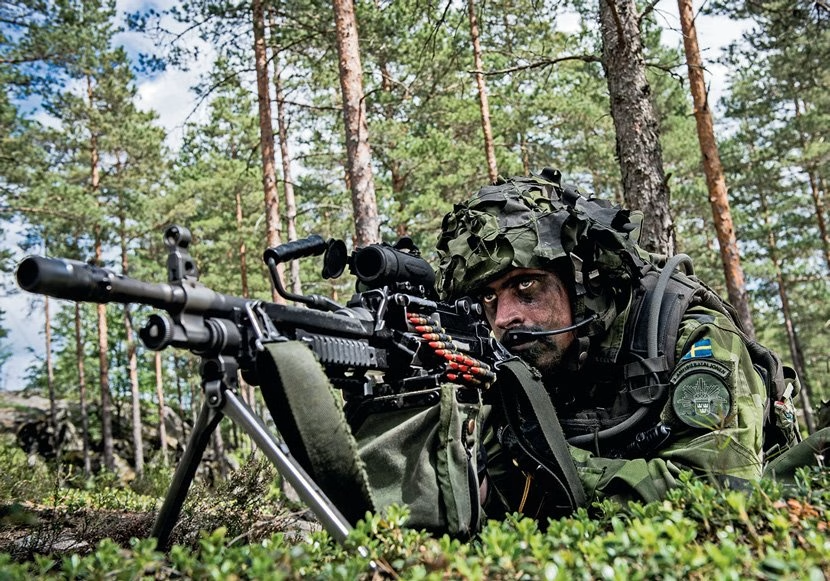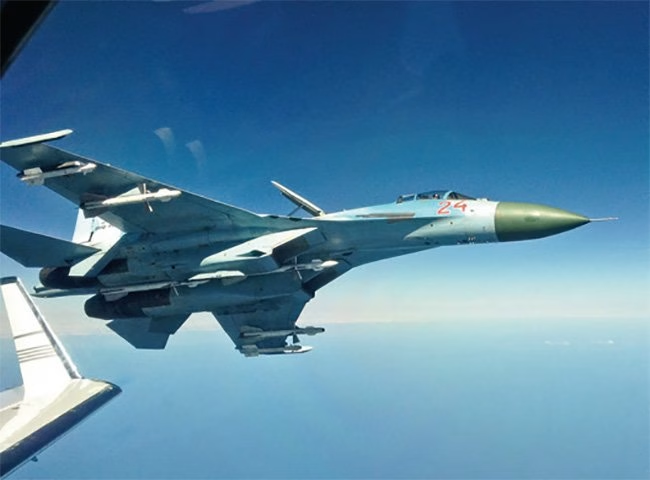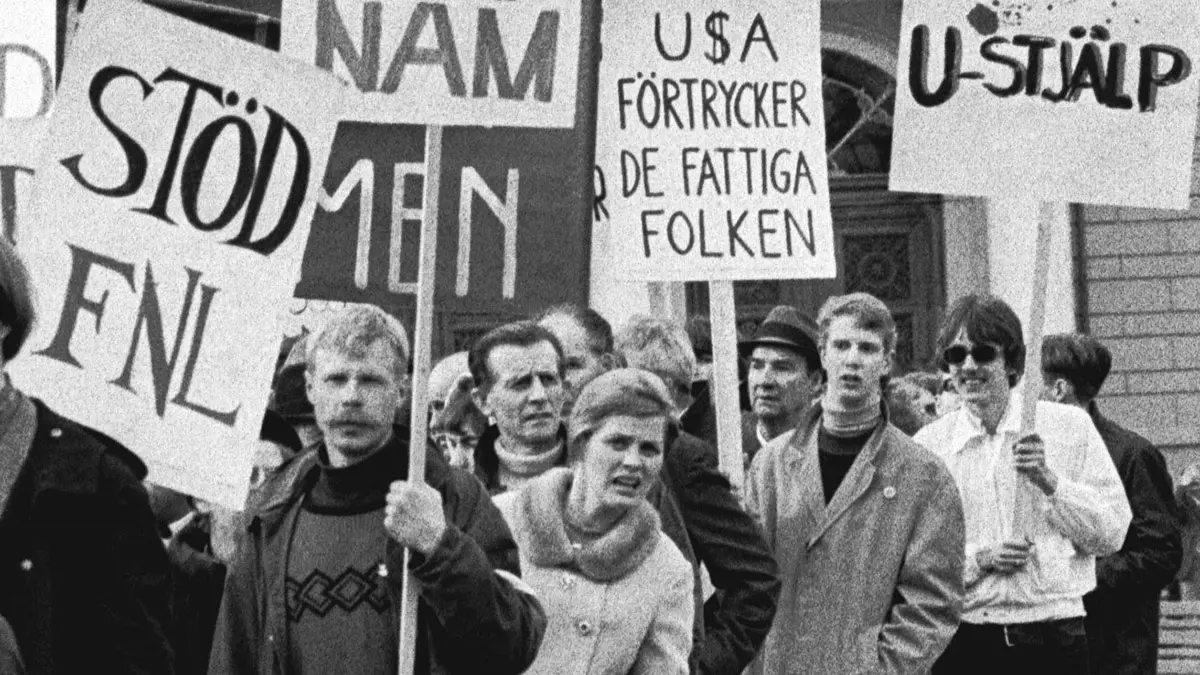In Finland, in one year, from 2013 to 2014, the percentage of Finns who think it likely or very likely that Finland will be threatened militarily during the next decade increased from 7% to 21%.
If war seeks us out, what might it look like and will we be ready? One way to address this is through scenarios. The scenarios can be concrete or conceptual, either type enabling us to better understand how ’Warfare of the Mind’, ‘Surprise & Awe’ or the term du jour ‘Hybrid war’ may play out.
If you look at the career path of a Finnish man who completed his one year conscription service in 1983, he was witnessing the last escalatory spiral of the Cold War. Intermediate-range nuclear missiles in Europe and the Strategic Defence Initiative or Star Wars were on everyone’s lips. He would have participated in military exercises that revolved around territorial defence, though the potential opponent was always diffuse, though obvious in practice.
Six years later, as a recent graduate of the Cadet school and newly minted Senior Lieutenant, he would have scarcely believed that the Cold War had ended while he was in school, taking with it the threat of nuclear Armageddon – or so he would have thought. He would have had to cancel all leave and prepare for possible refugees as news of the Coup attempt in Moscow and the Soviet Union’s dissolution became public. Focus remained on territorial defence, but the likelihood it would be needed was decreasing.
In the mid-1990s as a Captain he could have been among the first Finns to participate in a NATO-led operation in the Balkans. By this time the threat of a continental war in Europe ending in the use of nuclear weapons had become remote concept, to say the least. The popular image of war was dominated by civil war, whether in Africa or the Balkans, a mixture of intra and interstate war that was conceptually and practically different from the Big War that most of Europe had been preparing for during the Cold War. Peacekeeping and Crisis Management had begun to replace Big War as activities western militaries were tasked with, or asked to prepare for.
The young Captian would have heard his fellow officers from NATO countries reflect on talk about ”out of area or out of business”, of peacekeeping operations becoming the primary task for the armed forces of NATO-members. He would, however, have returned to Finland to continue training conscripts to defend Finland.
By 2009 this Colonel would have served in Afghanistan, where Counterinsurgency and its associated capabilities had become de rigeur; primarily all-volunteer forces often with little civilian life experience seeking to win the hearts and minds of civilians in Afghanistan. Sitting by himself in a tent in Camp Marmal in Northern Afghanistan he might have jotted down some thoughts, about how the strongest military alliance in the world was indeed becoming more interoperable but was ultimately learning the wrong game – preparations for collective defence in Europe were still seen as optional.
In our time – today – this Finnish man, now with the lions signifying general officer status, could observe that the kind of war much of the west has engaged in changes frequently. Moreover, that it changes at a pace faster than our capability development, which often takes decade(s) if done well. Larger countries may previously have had the luxury of continuously changing foci and development paths, but even they are stretched today. Smaller countries, like Finland, never have.
This General would reflect on the fact that Finland has for his whole career, against all advice and peer-pressure, continued to focus on nationally existential military threats, on building and maintaining a modern territorial defence and a societal ’deep security’ (more on this later). Together these form the basis of a fairly robust defence against war – though of course not things nuclear.
The obvious rejoinder is to ask: what kind of war? The skill to define war definitively resides in far more experienced hands. Rather, the aim is to open up some thinking regarding what War in Our Time in Our Region could look like. To do this, I’m going to present a few scenarios.
First, to understand some parts regarding Finland, it is necessary to understand that there is a rather clear division within Finland regarding how war is seen. In general, the political establishment sees war a Distinct and Rare. While this is not quite a binary Peace/War division, there is a clear sense that to misappropriate Larry Flynt, ’they know war when they see it’ – which is good, since it’s ultimately their decisions (to mobilize or react to military aggression) which we rely on. The reality is of course nothing like that, as can be seen from 2009 Helsingin Sanomat op-ed where I argued that Finland was party to a war in Afghanistan. Within hours of publication both the defence and foreign ministers in Finland had been dragged out of meetings to denounce the idea on television; the defence minister saying there was no factual basis for such a statement and the foreign minister going even further, saying it was irresponsible to even suggest such a thing. A few people in this room may through person experience have a rather different view on whether a war was going on in Afghanistan in 2009.
Fortunately, much of the military sees war as being a regular nearly ongoing feature of our time, as well as a non-binary space. Information operations, in the form of well-placed articles interview and statements; the purposeful violation of national borders in the air and potentially under the sea; and, procurement of property by Russian actors near every significant Finnish military base are certainly not as clear as Russian tanks rolling across the border in eastern Ukraine but neither are they the sign of normal peaceful neighborly relations.
This latter view of the frequency and unclear nature of war doves nicely with the approach to warfare that has become the term du jour ’Hybrid’ or ‘non-linear war’. Without a long discussion about the provenance of the term and what its evolution even during the past few years, a recent report by Andras Racs from the Finnish Institute of International Affairs identifies five prerequisites for Hybrid war of the kind Russia has employed in Ukraine to be successful. First, Russia must be militarily stronger than the attacked country (credibility of a conventional attack must exist as a deterrence). Second, the must be lasting, regionally-concentrated dissatisfaction with the central government. Third, a large presence of Russian-speaking minority as a source of a possible legitimacy (to act) claim. Fourth, media superiority in the form of strong media presence both in the target country and internationally. Fifth, logistics requires either a legitimate presence of Russian forces nearby (Sevastopol naval base on Crimea) or that the territory is neighboring Russia and the border control is weak (eastern Ukraine).
If one takes these five prerequisites in to consideration, it is relatively easy to present a case that Finland is quite robust against attempts to use hybrid war in the form we’ve seen. The argument for why Finland is structurally well placed to withstand hybrid warfare is based on four components. First, there is a fundamental strength to society built upon democracy, rule of law, universal education and literacy, relative socio-economic equality and freedom of speech and media. The Fund for Peace Fragile States Index (which uses over a hundred social, political and economic indicators) has ranked Finland as the most sustainable and least fragile state in 2011, 2012, 20013, 2014 and again in 2015.
Second, there is a broad concept of security, with Finland’s defence capability making up only one of seven vital functions of society that the government has identified in successive societal security reviews. Third, Finland has built up a dense security cooperation network, seeking to ensure that irrespective of the kind of security challenge the society is faced with, suitable partners can be found and relied upon, whether from among other states, the private or third sectors. Fourth, as described above, Finland has maintained and continues to modernize a functioning national defence system.
The form of Hybrid warfare we’ve seen may not be that effective, but what we will see are different versions of it, with each new iteration and case requiring a mixture of different proportions of the ingredients. For now, the two other conceptual approaches to warfare that seem most relevant, ’Warfare of the Mind’ and ‘Surprise & Awe’, demand some deeper thought from a Finnish and Nordic perspective. Warfare of the Mind – an extension of reflexive control that includes cyber, information, diplomatic, political and non-military physical actions are continuously aimed by Russia at Finland, though sometimes Finland is really just in the firing line and not the main target. In any case, it is real, has an impact and is cost effective. ’Surprise & Awe’ will be addressed after descriptions of the two concrete scenarios that serve as possible examples of what war in our time in our region may look like.
The two scenarios presented below are based on three scenarios written with two colleagues, James Mashiri and Michael Moberg, and published in the Finnish weekly Suomen Kuvalenti in February 2015. Each scenario falls in the category between expected events such as airspace violations and speculative such as World War III. I’ve picked two, one regarding Gotland and one Finland.
Gotland is an island that has figured heavily in Swedish discussions about security and defence policy. The scenario starts with an increasingly tense security situation in the Baltic Sea region, and envisions an operation beginning with the elimination of Hemvärnet leadership, destruction of pre-positioned vehicles/tanks and downing of a JAS Gripen sent over Gotland on a reconnaissance mission, all ostensibly by the newly formed armed forces of the Gotland Folkrepublik. Diverse terrorist actions causing societal instability on the mainland follow and the next day Russian air and seaborne troops land on Gotland. Swedish attempts to stave off the landings are only partially successful, as the Swedish Defence Forces are still too oriented towards international crisis management operations. Soon S-400s and Pantsir S-1 airdefence systems make flying in large parts of the Baltic Sea dangerous. Soon Finnish politicians must consider whether to let Sweden use Finnish facilities and capabilities to intercept additional Russian military units.
The purpose of the scenario was to highlight the immediate military and political demands such a sudden escalation would place on Finnish political decisionmaking. When published the major criticism of the scenario was that ”it wouldn’t make any sense for Russia to do this” or that “it could not keep Gotland long-term/permanently”. While the latter would be true, we the authors challenged the former criticism. Something making sense assumes a potential adversary’s goals, aims and logics are similar to your own – a perfect case of mirror imaging. Is this scenario likely? No, it was not meant to be a prediction of the future. Is it conceivable? Yes, and based on a lot of thinking around the subject. Is it more likely now than five years ago? Absolutely.
The second scenario we sketched out related to the Åland Islands, a demilitarized archipelago that has significant autonomy but falls under Finland’s sovereignty. The initial demilitarization was the result of the Crimean War in 1850s. Its status was set by the League of Nations in 1921, during which an agreement to neutralize the islands was also agreed to. The Soviet Union and its follower Russia have, however, never agreed to neutralization (in war).
The scenario begins with increasing threats and actual attacks against Russian energy infrastructure in the Bay of Finland. Russia eventually announces that it is forced to seek stronger control of the maritime regions because western supported actors are trying to strangle Russian energy exports. Potential sightings of sea mines provide Russia with excuse to move ships close to Finnish borders; and, Russia suggests Finnish countermine ships stay in their harbors. The Finnish government is unwilling to enact Emergency Laws, for fear of further escalating the situation – a decision which delays and ultimately would thwart appropriate defensive measures being taken by the Finnish military in a timely fashion. In the end Russia argues that the threats it sees are unlikely to be short-term and the Finnish political leadership is given an ultimatum regarding the need to establish a shared naval base. This scenario was also criticized, mainly because the Finnish political decision makers were thought to be acting too passively and that Russia would not (a) be willing to stage such an elaborate play to manufacture a threat to its strategic energy infrastructure or (b) be ready to threaten with the use military force to simply gain a military base. The relative passivity of the government in the scenario is supported by insights gained from diverse sources, and simply threatening use of force to gain the upper hand in political negotiations is something we continue to see. Is this scenario likely? No. Is it conceivable? Oh yes, more so than Gotland. Is it more likely now than five years ago? Absolutely.
The obvious question is why Russia would do anything like this? The shortest possible answer is, to ensure its sphere of influence and weaken (possibly break) the EU and if possible NATO. Of course, if it can achieve this, a de facto sphere of influence and severely politically, economically and militarily weakened Europe without resorting to military force, all the better. Sometimes the threat of military force can get an opponent to make a favorable decision without the need to use force.
All of the scenarios and the leadups to them have one common thread, maybe even requirement: that we be surprised. It is this denial of surpriseability which is perhaps the greatest asset that Russia would have in both of the scenarios I describe. Too many in Finland and Sweden are not willing to accept that surprise actually has worked quite frequently in history.
Because this concept of surprise is so central to the possibility of War in Our Time in our Region, I will explain its relevance briefly. To do so I will borrow from work by a two retired Colonels, Bo Hugemark from Sweden and Anders Gardberg from Finland (Anders was Finnish defence attaché in Stockholm until 2014 and is now head of SAAB Defence in Finland).
The key point is that for a variety of reasons, political decisionmakers actually don’t recognize war until it is too late.
In Sweden the current general situation with frequent readiness exercises, violations of sovereignty, and aggressive strike exercises by Russia is frequently described as the new normal. This idea that all of these actions have become commonplace has also impacted military intelligence, as old warning indicators are no longer valid to the same degree.
Previously the expectation was that Finnish military intelligence would provide ample time and unambiguous evidence about the upcoming use of force. Neither of these expectations holds now. Russia can make continuous preparations for the use of force and then launch the forces directly out of peacetime/readiness control positions. This means the forewarning that intelligence can hope to give is measured in days or maximally weeks, and that the evidence is unlikely to be unambiguous. Moreover, it is highly probable that while making its own preparations, Russia would exert political and diplomatic pressure to try to forestall and delay the opponent’s decision making regarding, for example, mobilization.
Even if in this case Finnish politicians were to make the decision to significantly raise readiness, there are limits to how long a small country can maintained a heightened state of alert; in this particular case Sweden is probably even worse off. This means that the more limited resources of small countries mean that even when warning signs have been accepted, it is possible that actual mobilization occurs too late.
Though not unique to Finland and Sweden, there is also a well-established track-record of happily deceiving ourselves. For example in our case by saying that Russia doesn’t have the capability to do ”x” and more recently arguing that “it wouldn’t make sense” or “Russia wouldn’t benefit from war/conflict” etc., and explaining away occurrences that would serve as red flags to outside observers. We’re also not great at estimating the risks a potential attacker is willing to take (since we frequently don’t know what the ’final goal’ is) and generally speaking we’re pretty happy with our lives – war would be an extremely unwelcome guest.
All of this is likely to lead to the kinds of delays in raising readiness that are described in the scenarios.
Combine this with a tendency by those willing to use military force for political ends to produce fait accompli situations (Adolf Hitler, Saddam Hussein, Vladimir Putin) and it becomes easier to see how ’Surprise & Awe’ must be considered a compelling approach to warfare in our time in our region. Combining a surprising use of conventional force with a sudden demand for ‘nuclear de-escalation’ and immediate economic pressure would combine to form a potent challenge to Finland. Here it must be explained that under current Russian military thinking, nuclear de-escalation means that Russia presents the opposing side with an ultimatum that ends or freezes the conflict or Russia uses (tactical) nuclear weapons.
A barrage of cyber operations, information campaigns and electronic warfare would all be used to delay, confuse and otherwise impact decision makers, who might ultimately be faced with a decision where on the one side of the scale is national survival and on the other a temporary self-imposed limitation on sovereignty, such as not joining NATO. Is this flexible sovereignty, agreeing to a temporary shared naval base or denying others the use of Finnish airspace worth risking the long-term future of Finland?
Looking at recent events, it is because actors in our region answer these questions regarding sovereignty differently that we may yet see the unwelcome guest – war in our time in our region.
Charly Salonius-Pasternak is Senior Research Fellow at Finnish Institute of International Affairs.

Redan prenumerant?
Logga inUpptäck Axess Digital i 3 månader utan kostnad
Allt innehåll. Alltid nära till hands.
- Full tillgång till allt innehåll på axess.se.
- Tillgång till vårt magasinarkiv
- Nyhetsbrev direkt till din inbox











